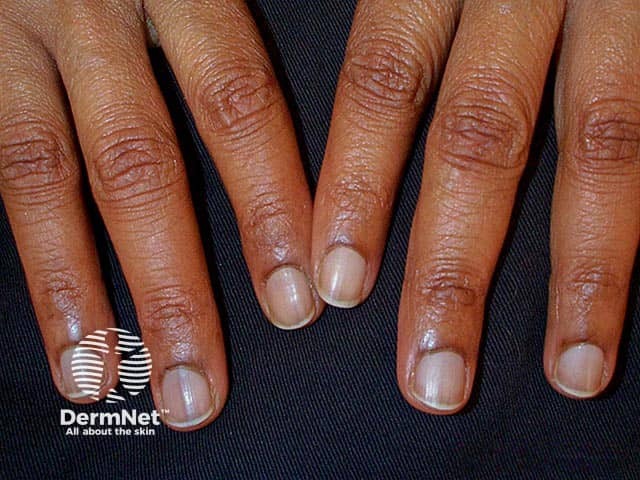Main menu
Common skin conditions

NEWS
Join DermNet PRO
Read more
Quick links
Laugier-Hunziker syndrome — extra information
What is Laugier-Hunziker syndrome?
Laugier-Hunziker syndrome is a harmless rare sporadic disorder that is characterised by flat brown marks on the lips and inside the mouth, and frequently brown stripes on the nails. It is important to distinguish it from Peutz-Jeghers syndrome, which has similar cutaneous features but also has associated gastrointestinal polyps.
Peutz-Jegher syndrome is due to mutation of the SKT11 gene. The cause of Laugier-Hunziker syndrome is unknown. It does not appear to run in families, although there has been one reported case involving a mother and two daughters with the condition. The syndrome occurs in early- to mid-adult life and affects both males and females.
What are the clinical features of Laugier-Hunziker syndrome?
The main clinical feature of Laugier-Hunziker syndrome is the appearance of pigmentation (dark spots) on the buccal mucosa (inner lining of the cheeks) and the lips (usually the lower lip). Sometimes pigmentation is also found on the gingiva (gums), tongue, and roof of the mouth. Features of the lesions are:
- brown, black or slate marks that have a smooth surface
- they appear as solitary spots, grouping of multiple spots, or spots joined together to form patches
- usually 5mm or less in diameter, but buccal lesions of 1cm have been reported
Oral hyperpigmentation may be accompanied by nail and/or skin pigmentation. Oral and nail involvement is found in about 60% of cases. Nail pigmentation is permanent and appears in the following ways:
- one longitudinal band per nail, 1-8 mm thick
- two longitudinal bands per nail, 1-8 mm thick
- pigmentation of half a nail
- complete pigmentation of a nail
Skin hyperpigmentation is sometimes found on the neck, abdomen, fingers, palms, soles and genital region.

Pigmented macules on the tongue in Laugier-Hunziker syndrome

A pigmented band on the right middle fingernail in Laugier-Hunziker syndrome
See more images of Laugier-Hunziker syndrome
What is the treatment for Laugier-Hunziker syndrome?
No treatment is required for Laugier-Hunziker syndrome. Laugier-Hunziker has no association with systemic diseases so there are few if any complications. If systemic symptoms are apparent a patient must be worked-up for another diagnosis.
Cosmetically disfiguring or bothersome lesions may be treated with laser therapy.
References
- Book: Textbook of Dermatology. Ed Rook A, Wilkinson DS, Ebling FJB, Champion RH, Burton JL. Fourth edition. Blackwell Scientific Publications.
- Duong BT, Winship I. The role of STK 11 gene testing in individuals with oral pigmentation. Australas J Dermatol. 2017 May;58(2):135–8. doi: 10.1111/ajd.12443. Epub 2016 Jan 14. PubMed PMID: 26768676. PubMed.
On DermNet
Other websites
- Laugier-Hunziker Syndrome — Medscape Reference
